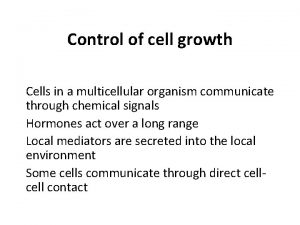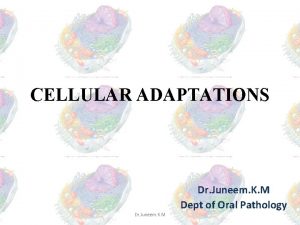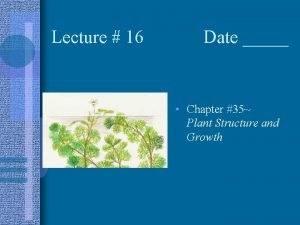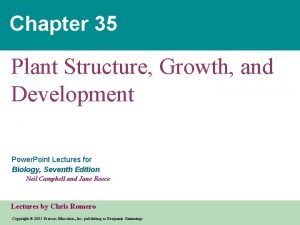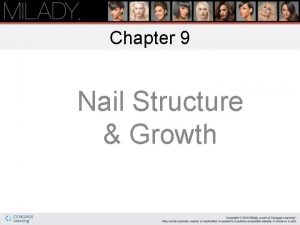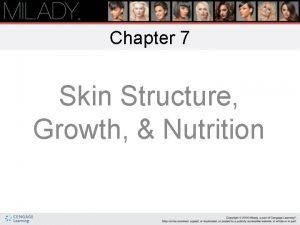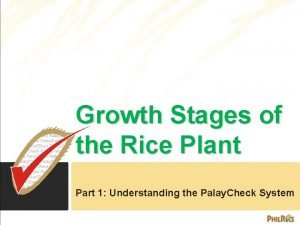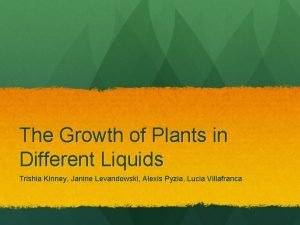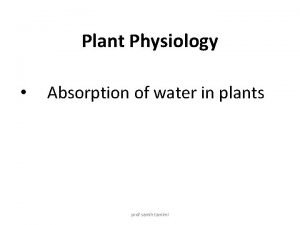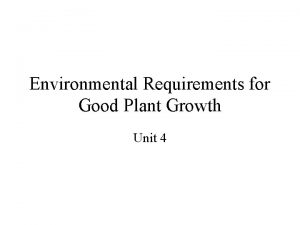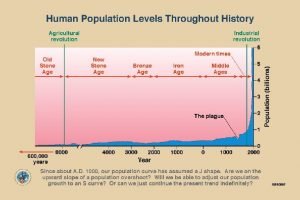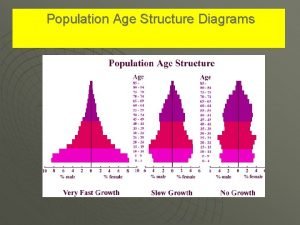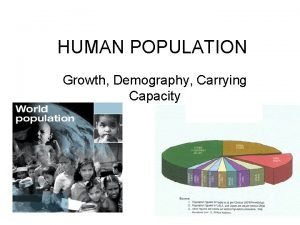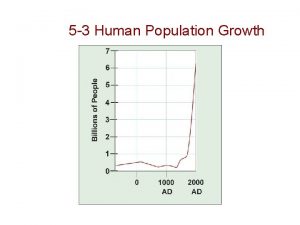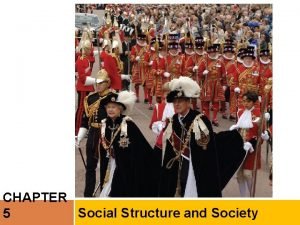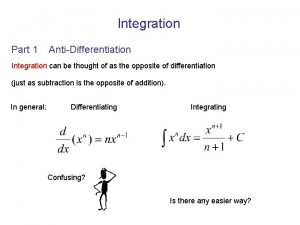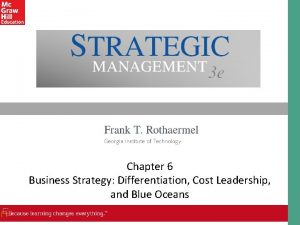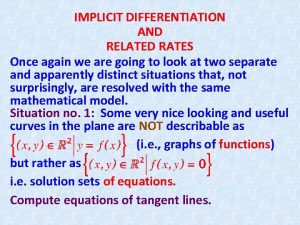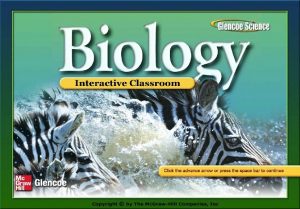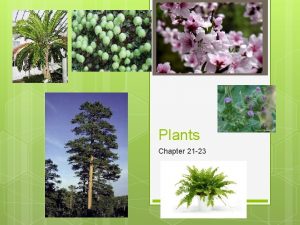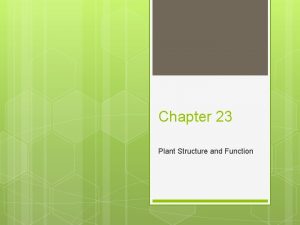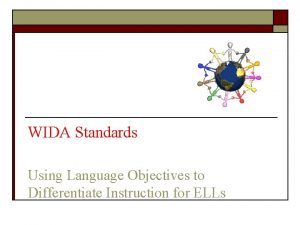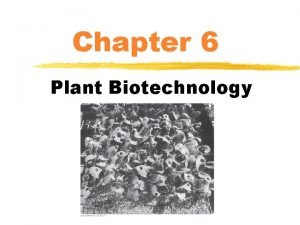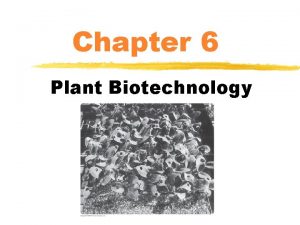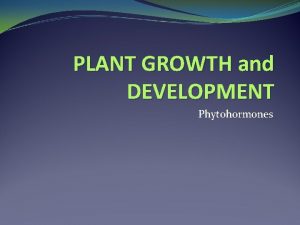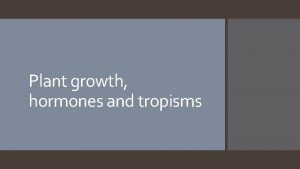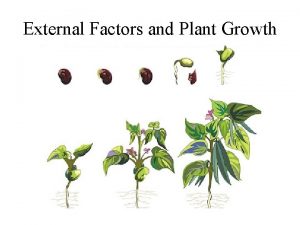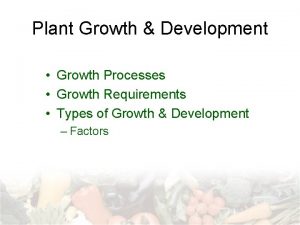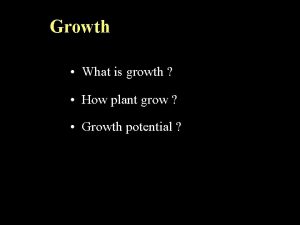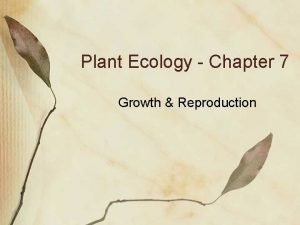Ch 31 Plant Structure Growth and Differentiation Plant





















































- Slides: 53

Ch. 31 – Plant Structure, Growth and Differentiation

Plant Body • Root system – Underground – Anchor and absorb • Shoot system – Vertical stem, leaves (flowers, fruits w/seeds) – photosynthesis

Fig. 35 -2 Reproductive shoot (flower) Apical bud Node Internode Apical bud Vegetative shoot Leaf Shoot system Blade Petiole Axillary bud Stem Taproot Lateral branch roots Root system

Plant Cells and Tissues • Ground tissue system – majority – Photosynthesis, storage, support • Vascular tissue system – Conduction, strength, support • Dermal tissue system – Covering, protection All 3 are Interconnected throughout the plant

Fig. 35 -8 Dermal tissue Ground tissue Vascular tissue

Ground Tissue System • Parenchyma, collenchyma, sclerenchyma tissue • Primary cell wall – secreted by growing cell; stretches and expands as cell grows • Secondary cell wall – secreted when cell stops growing; thick and strong (inside primary)

Parenchyma • • Living, metabolizing Most common Soft parts Function – Photosynthesis – green chloroplasts – Storage – starch, oil, water, salt – Secretion – resins, tannins, hormones, enzymes, nectar • Can differentiate if plant injured (i. e. xylem cells)

Fig. 35 -10 a Parenchyma cells in Elodea leaf, with chloroplasts (LM) 60 µm

Parenchyma

Collenchyma Flexible, structural support (nonwoody parts) Elongated cells Alive at maturity Primary CW – unevenly thick, thicker in corners • Near stem surface, leaf veins • •

Fig. 35 -10 b 5 µm Collenchyma cells (in Helianthus stem) (LM)

Collenchyma

Sclerenchyma • Structural support • Primary and secondary CW (strong and hard, extreme thickening, so can’t stretch, elongate) • Cells dead at maturity • 2 types: – Sclereids – variable shape, nut shells, pits of stone fruits, pears gritty (clusters of sclereids) – Fibers – long, tapered – patches, clumps; wood, inner bark, leaf veins

Sclerenchyma

Fig. 35 -10 c 5 µm Sclereid cells in pear (LM) 25 µm Cell wall Fiber cells (cross section from ash tree) (LM)

Vascular tissue • Embedded in ground tissue • Transport • Xylem and phloem

Xylem • Conducts water, dissolved nutrient minerals roots stems, leaves • Support • Angiosperms – – tracheids, vessel elements - conduct – parenchyma cells - storage – fibers - support

Tracheids and vessel elements • Dead at maturity hollow, CW remain • Tracheids – long, tapering, patches/clumps; water passes from 1 tracheid to another by pits (thin areas where sec. wall did not form) • Vessel elements – larger in diameter than tracheid; end walls have perforations; stacked water goes between; stack = vessel; pits in side walls for lateral water transport

Fig. 35 -10 d Vessel Tracheids 100 µm Pits Tracheids and vessels (colorized SEM) Perforation plate Vessel elements, with perforated end walls Tracheids

Phloem • Conducts food • Support • Angiosperms – Sieve tube members, companion cells – conduct – Fibers – support – Parenchyma cells

Sieve tube members • Conduct food in solution • Joined end-to-end long tubes • CW ends = sieve plates; cytoplasm extends between cells • Living at maturity – many organelles shrink/disintegrate • Can function w/o nuclei

Companion cells • Adjacent to each sieve tube member (stm) • Assists stm • Living w/ nucleus – directs activities of both cells • Plasmodesmata between stm and companion • Helps move sugar into stm

Fig. 35 -10 e Sieve-tube elements: longitudinal view (LM) 3 µm Sieve plate Sieve-tube element (left) and companion cell: cross section (TEM) Companion cells Sieve-tube elements Plasmodesma Sieve plate Nucleus of companion cells Sieve-tube elements: longitudinal view 30 µm 10 µm Sieve plate with pores (SEM)

Food conducting

Dermal tissue system • • Epidermis and periderm Protective covering Herbaceous – single layer = epidermis Woody – epidermis splits w/ growth – Periderm – layers thick, under epidermis; replaces epidermis in stems, roots, composing outer bark

Epidermis • • Unspecialized dermal cells Special guard cells + trichomes Single layer, flat cells Usually no chloroplasts transparent – Allow light through

Fig. 35 -18 a Key to labels Dermal Ground Vascular Cuticle Sclerenchyma fibers Stoma Upper epidermis Palisade mesophyll Spongy mesophyll Bundlesheath cell Lower epidermis Cuticle Xylem Vein Phloem (a) Cutaway drawing of leaf tissues Guard cells

Fig. 35 -18 b Guard cells 50 µm Stomata pore Epidermal cell (b) Surface view of a spiderwort (Tradescantia) leaf (LM)

Fig. 35 -18 c Key to labels Dermal Ground Upper epidermis Palisade mesophyll Vascular 100 µm Spongy mesophyll Lower epidermis Vein Air spaces Guard cells (c) Cross section of a lilac (Syringa) leaf (LM)

Cuticle • • • Aerial parts Secreted by epidermal cells Waxy – water loss Slows diffusion of CO 2 – stomata help Stomata – Open – day – photosynthesis, evaporative cooling – Closed – night – Closed in day if drought

Trichomes • Outgrowths or hairs • Many shape, sizes, functions • Ex: – Roots hairs – increase SA – Salty env. – remove excess salt – Aerial parts – increase light reflection, cooler – Protections – stinging nettles

Growth at Meristems • Cell division – Increase # cells • Cell elongation – Vacuole fills, increase pressure on CW, expands • Cell differentiation – Specialize into cell types • Meristems = where plant cells divide, mitosis – No differentiation

2 kinds of Growth • Primary growth – Increase stem, root length – All plants, soft tissues • Secondary growth – Increase width – Gymnosperms, woody dicots – Wood + bark

Fig. 35 -11 Primary growth in stems Epidermis Cortex Shoot tip (shoot apical meristem and young leaves) Primary phloem Primary xylem Pith Lateral meristems: Axillary bud meristem Vascular cambium Cork cambium Secondary growth in stems Periderm Cork cambium Cortex Root apical meristems Pith Primary xylem Secondary xylem Vascular cambium Primary phloem Secondary phloem

Primary growth • Increase in length • Apical meristem – tips of roots + shoots (buds) • Buds = dormant embryonic shoot (develop into branches next spring • Root tip – Root cap – protective layer of cells, covers root tip – Root apical meristem – directly behind root cap – Cell elongation – behind meristem, push tip ahead, some differentiation

Fig. 35 -13 Cortex Vascular cylinder Epidermis Key to labels Dermal Root hair Zone of differentiation Ground Vascular Zone of elongation Apical meristem Root cap 100 µm Zone of cell division


Fig. 35 -14 a 1 Epidermis Cortex Key to labels Dermal Endodermis Ground Vascular cylinder Pericycle Xylem 100 µm (a) Root with xylem and phloem in the center (typical of eudicots) Phloem

Fig. 35 -14 a 2 (a) Root with xylem and phloem in the center (typical of eudicots) Endodermis Key to labels Pericycle Dermal Ground Vascular Xylem Phloem 50 µm

Fig. 35 -14 b Epidermis Cortex Endodermis Key to labels Vascular cylinder Pericycle Dermal Ground Vascular Core of parenchyma cells Xylem Phloem 100 µm (b) Root with parenchyma in the center (typical of monocots)

• Shoot apex = terminal bud – Shoot meristem – Give rise to leaf primordia and bud primordia

Fig. 35 -16 Shoot apical meristem Leaf primordia Young leaf Developing vascular strand Axillary bud meristems 0. 25 mm

Fig. 35 -17 a Phloem Xylem Sclerenchyma (fiber cells) Ground tissue connecting pith to cortex Pith Key to labels Cortex Epidermis Vascular bundle Dermal Ground 1 mm (a) Cross section of stem with vascular bundles forming a ring (typical of eudicots) Vascular

Fig. 35 -17 b Ground tissue Epidermis Key to labels Dermal Vascular bundles Ground Vascular 1 mm (b) Cross section of stem with scattered vascular bundles (typical of monocots)

Secondary Growth • Increase in width • Make secondary tissues: sec. xylem, sec. phloem, periderm • Lateral meristem – cells divide, not elongate • 2 types: – Vascular cambium • Between wood and bark • Make sec. xylem (wood) + sec. phloem (inner bark)

Fig. 35 -20 Vascular cambium Growth X X C P P Secondary xylem Secondary phloem X C P C C X X C P Vascular cambium C C C X C C C After one year of growth After two years of growth

Fig. 35 -22 Growth ring Vascular ray Heartwood Secondary xylem Sapwood Vascular cambium Secondary phloem Bark Layers of periderm


– Cork cambium • In outer bark • Form cork to outside +parenchyma (storage) • Periderm = cork, parenchyma, cork cambium

• Bark – outermost covering of woody stems – Everything outside of vascular cambium – 2 regions: • Living inner bark of secondary phloem • Mostly dead outer bark of periderm

Fig. 35 -19 a 3 Pith Primary xylem Vascular cambium Primary phloem (a) Primary and secondary growth in a two-year-old stem Epidermis Cortex Epidermis Primary phloem Vascular cambium Primary xylem Pith wth Gro Vascular ray Secondary xylem Secondary phloem First cork cambium Cork Periderm (mainly cork cambia and cork) Most recent cork cambium Secondary phloem Bark Secondary xylem Cork Layers of periderm

Fig. 35 -19 b Secondary xylem Secondary phloem Vascular cambium Late wood Early wood Bark Cork cambium Periderm 0. 5 mm Cork Vascular ray 0. 5 mm Growth ring (b) Cross section of a three-yearold Tilia (linden) stem (LM)

You should now be able to: 1. Compare the following structures or cells: – Dermal, vascular, and ground tissues – Parenchyma, collenchyma, sclerenchyma, waterconducting cells of the xylem, and sugarconducting cells of the phloem – Sieve-tube element and companion cell 2. Describe in detail the primary and secondary growth of the tissues of roots and shoots 3. Describe the composition of wood and bark
 Cellular adaptation of growth and differentiation
Cellular adaptation of growth and differentiation Cellular adaptation of growth and differentiation
Cellular adaptation of growth and differentiation Chapter 35 plant structure growth and development
Chapter 35 plant structure growth and development Plant structure growth and development
Plant structure growth and development Primary growth and secondary growth in plants
Primary growth and secondary growth in plants Relative growth rates
Relative growth rates Monocots eudicots
Monocots eudicots Primary growth and secondary growth in plants
Primary growth and secondary growth in plants Carothers equation
Carothers equation Geometric growth population
Geometric growth population Neoclassical growth theory vs. endogenous growth theory
Neoclassical growth theory vs. endogenous growth theory Difference between organic and inorganic growth
Difference between organic and inorganic growth Enumerate the rice plant growth and development stages
Enumerate the rice plant growth and development stages Plant growth and development ppt presentation
Plant growth and development ppt presentation Chapter 9 nail structure and growth review questions
Chapter 9 nail structure and growth review questions Milady nail structure and growth
Milady nail structure and growth Skin structure growth and nutrition
Skin structure growth and nutrition Sri system of rice intensification
Sri system of rice intensification Plant growth with different liquids
Plant growth with different liquids Significance of transpiration
Significance of transpiration Observation of plant growth day by day
Observation of plant growth day by day Environmental requirements for good plant growth
Environmental requirements for good plant growth Plant growth patterns
Plant growth patterns Tronsmo plant pathology and plant diseases download
Tronsmo plant pathology and plant diseases download Tronsmo plant pathology and plant diseases download
Tronsmo plant pathology and plant diseases download Tronsmo plant pathology and plant diseases download
Tronsmo plant pathology and plant diseases download Slow growth age structure diagram
Slow growth age structure diagram Age structure diagram slow growth
Age structure diagram slow growth Pre reproductive age
Pre reproductive age Age structure diagram slow growth
Age structure diagram slow growth Slow growth age structure diagram
Slow growth age structure diagram 5-3 human population growth
5-3 human population growth Social growth outline structure
Social growth outline structure Difference between udl and differentiation
Difference between udl and differentiation Porter's competitive strategies
Porter's competitive strategies Delayed differentiation and modular design
Delayed differentiation and modular design Antidifferentiation
Antidifferentiation Timex cost leadership strategy
Timex cost leadership strategy Blue ocean strategy meaning
Blue ocean strategy meaning Service design generally differs from product design
Service design generally differs from product design Segmentation targeting differentiation and positioning
Segmentation targeting differentiation and positioning Implicit differentiation xy
Implicit differentiation xy Segmentation
Segmentation Implicit differentiation and related rates
Implicit differentiation and related rates Designs may be frozen with too many imperfections remaining
Designs may be frozen with too many imperfections remaining Plant cell strucutre
Plant cell strucutre Chapter 22 plant structure and function answer key
Chapter 22 plant structure and function answer key Chapter 21 plant structure and function
Chapter 21 plant structure and function Chapter 23 plant structure and function
Chapter 23 plant structure and function Plant introduction
Plant introduction Plant breeding for disease resistance
Plant breeding for disease resistance Plant introduction in plant breeding
Plant introduction in plant breeding Wida language objectives examples
Wida language objectives examples High accuracy differentiation formulas
High accuracy differentiation formulas
